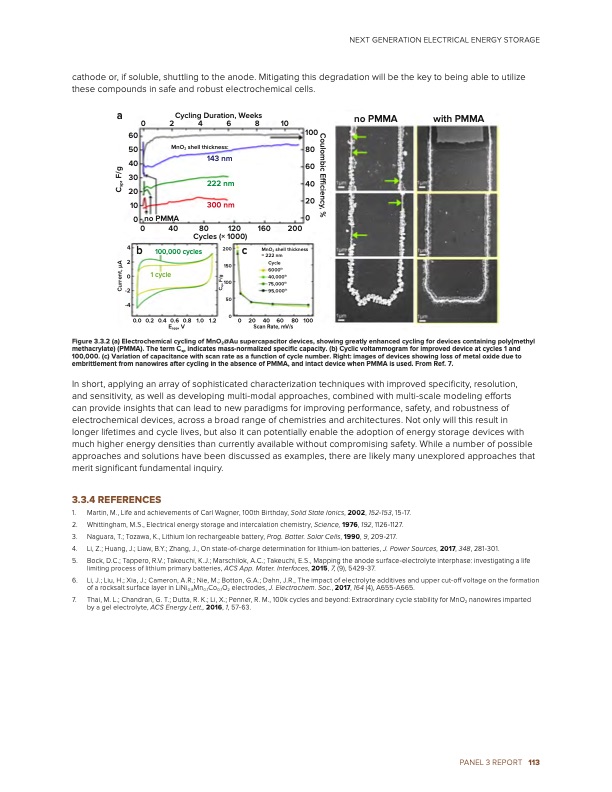
PDF Publication Title:
Text from PDF Page: 119
cathode or, if soluble, shuttling to the anode. Mitigating this degradation will be the key to being able to utilize these compounds in safe and robust electrochemical cells. a Cycling Duration, Weeks 0 2 4 6 8 10 100 MnO2 shell thickness: 80 143 nm 60 222 nm 40 no PMMA with PMMA 4 2 0 -2 -4 0 b 100,000 cycles 1 cycle 200 c MnO2 shell thickness no PMMA 0 0 40 80 120 160 200 Cycles (× 1000) 0.00.20.40.60.8 1.0 1.2 0 0 20 40 60 100 Eapp, V Scan Rate, mV/s = 222 nm 150 Cycle 6000th 40,000th 100 75,000th 95,000th 50 Figure 3.3.2 (a) Electrochemical cycling of MnO2@Au supercapacitor devices, showing greatly enhanced cycling for devices containing poly(methyl methacrylate) (PMMA). The term Csp indicates mass-normalized specific capacity. (b) Cyclic voltammogram for improved device at cycles 1 and 100,000. (c) Variation of capacitance with scan rate as a function of cycle number. Right: images of devices showing loss of metal oxide due to embrittlement from nanowires after cycling in the absence of PMMA, and intact device when PMMA is used. From Ref. 7. In short, applying an array of sophisticated characterization techniques with improved specificity, resolution, and sensitivity, as well as developing multi-modal approaches, combined with multi-scale modeling efforts can provide insights that can lead to new paradigms for improving performance, safety, and robustness of electrochemical devices, across a broad range of chemistries and architectures. Not only will this result in longer lifetimes and cycle lives, but also it can potentially enable the adoption of energy storage devices with much higher energy densities than currently available without compromising safety. While a number of possible approaches and solutions have been discussed as examples, there are likely many unexplored approaches that merit significant fundamental inquiry. 3.3.4 REFERENCES 1. Martin, M., Life and achievements of Carl Wagner, 100th Birthday, Solid State Ionics, 2002, 152-153, 15-17. 2. Whittingham, M.S., Electrical energy storage and intercalation chemistry, Science, 1976, 192, 1126-1127. 3. Naguara, T.; Tozawa, K., Lithium Ion rechargeable battery, Prog. Batter. Solar Cells, 1990, 9, 209-217. 4. Li, Z.; Huang, J.; Liaw, B.Y.; Zhang, J., On state-of-charge determination for lithium-ion batteries, J. Power Sources, 2017, 348, 281-301. 5. Bock, D.C.; Tappero, R.V.; Takeuchi, K.J.; Marschilok, A.C.; Takeuchi, E.S., Mapping the anode surface-electrolyte interphase: investigating a life limiting process of lithium primary batteries, ACS App. Mater. Interfaces, 2015, 7, (9), 5429-37. 6. Li, J.; Liu, H.; Xia, J.; Cameron, A.R.; Nie, M.; Botton, G.A.; Dahn, J.R., The impact of electrolyte additives and upper cut-off voltage on the formation of a rocksalt surface layer in LiNi0.8Mn0.1Co0.1O2 electrodes, J. Electrochem. Soc., 2017, 164 (4), A655-A665. 7. Thai, M. L.; Chandran, G. T.; Dutta, R. K.; Li, X.; Penner, R. M., 100k cycles and beyond: Extraordinary cycle stability for MnO2 nanowires imparted by a gel electrolyte, ACS Energy Lett., 2016, 1, 57-63. NEXT GENERATION ELECTRICAL ENERGY STORAGE 60 50 40 30 20 10 300 nm 20 PANEL 3 REPORT 113 Coulombic Efficiency, % Current, μA Csp, F/g Csp, F/g 80PDF Image | Next Generation Electrical Energy Storage

PDF Search Title:
Next Generation Electrical Energy StorageOriginal File Name Searched:
BRN-NGEES_rpt-low-res.pdfDIY PDF Search: Google It | Yahoo | Bing
Sulfur Deposition on Carbon Nanofibers using Supercritical CO2 Sulfur Deposition on Carbon Nanofibers using Supercritical CO2. Gamma sulfur also known as mother of pearl sulfur and nacreous sulfur... More Info
CO2 Organic Rankine Cycle Experimenter Platform The supercritical CO2 phase change system is both a heat pump and organic rankine cycle which can be used for those purposes and as a supercritical extractor for advanced subcritical and supercritical extraction technology. Uses include producing nanoparticles, precious metal CO2 extraction, lithium battery recycling, and other applications... More Info
| CONTACT TEL: 608-238-6001 Email: greg@infinityturbine.com | RSS | AMP |